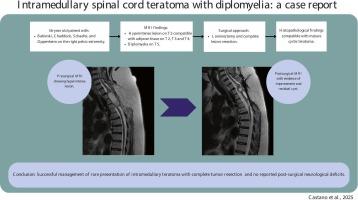脊髓畸胎瘤伴脊髓炎
IF 0.5
Q4 CLINICAL NEUROLOGY
Interdisciplinary Neurosurgery: Advanced Techniques and Case Management
Pub Date : 2025-08-05
DOI:10.1016/j.inat.2025.102107
引用次数: 0
摘要
脊髓髓性畸胎瘤极为罕见,仅占所有脊髓肿瘤的0.1-0.5%[1,2]。这些肿瘤在成人中特别罕见,很少有报道的病例能够完全恢复运动和感觉功能。我们提出的情况下,56岁的妇女谁经历了右腿疼痛和虚弱,并伴有感觉异常在右腹部区域。磁共振成像显示T2 - t3处髓内病变,伴T2至T4椎体萎缩,T5处椎体闭锁。患者接受后胸入路椎板切除术和肿瘤全切除术。组织病理学分析证实了成熟畸胎瘤的诊断,包括所有三个胚层的元素。结论:本病例说明了成功治疗罕见的成人髓内脊髓畸胎瘤伴伴多发性脊髓炎的可能性,表明完全手术切除可导致良好的神经系统预后。本文章由计算机程序翻译,如有差异,请以英文原文为准。

SPINAL CORD TERATOMA WITH DIPLOMYELIA
Background
Intramedullary spinal cord teratomas are exceedingly rare, accounting for only 0.1–0.5% of all spinal cord tumors [1,2]. These tumors are particularly uncommon in adults, with few reported cases achieving complete recovery of motor and sensory functions.
Case description
We present the case of a 56-year-old woman who experienced right leg pain and weakness accompanied by paresthesia in the right abdominal region. Magnetic resonance imaging revealed an intramedullary lesion at T2–T3, associated with vertebral body atrophy from T2 to T4 and diplomyelia at the T5 level. The patient underwent a posterior thoracic approach with laminectomy and complete tumor resection. Histopathological analysis confirmed the diagnosis of a mature teratoma comprising elements from all three germ layers.
Conclusions
This case illustrates the possibility of successful management of rare intramedullary spinal cord teratomas with associated diplomyelia in adults, demonstrating that complete surgical excision can lead to favorable neurological outcomes.
求助全文
通过发布文献求助,成功后即可免费获取论文全文。
去求助
来源期刊
CiteScore
1.00
自引率
0.00%
发文量
236
审稿时长
15 weeks

 求助内容:
求助内容: 应助结果提醒方式:
应助结果提醒方式:


